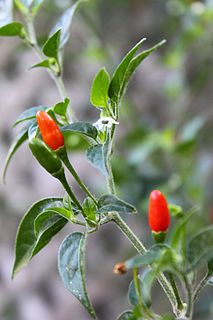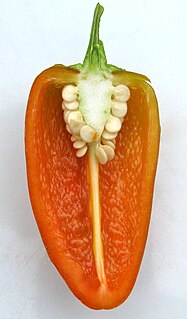| Look up Chile or chile in Wiktionary, the free dictionary. |
Chile is a country in South America.
Contents
Chile may also refer to:
| Look up Chile or chile in Wiktionary, the free dictionary. |
Chile is a country in South America.
Chile may also refer to:
Pepper or peppers may refer to:

The bell pepper is the fruit of plants in the Grossum cultivar group of the species Capsicum annuum. Cultivars of the plant produce fruits in different colours, including red, yellow, orange, green, white, and purple. Bell peppers are sometimes grouped with less pungent pepper varieties as "sweet peppers". While they are fruits—botanically classified as berries—they are commonly used as a vegetable ingredient or side dish.

The chili pepper, from Nahuatl chīlli, is the fruit of plants from the genus Capsicum which are members of the nightshade family, Solanaceae. Chili peppers are widely used in many cuisines as a spice to add heat to dishes. The substances giving chili peppers their intensity when ingested or applied topically are capsaicin and related compounds known as capsaicinoids.
Chili or chilli may refer to:
Aji or AJI may refer to:
Green pepper can refer to:

The jalapeño is a medium-sized chili pepper pod type cultivar of the species Capsicum annuum. A mature jalapeño chili is 5–10 cm (2–4 in) long and hangs down with a round, firm, smooth flesh of 25–38 mm wide. It can have a range of pungency, with Scoville heat units of 3,500 to 8,000. Commonly picked and consumed while still green, it is occasionally allowed to fully ripen and turn red, orange, or yellow. It is wider and generally milder than the similar Serrano pepper. The Chile Pepper Institute is known for developing colored variations.
Chilly may refer to:

The chile relleno is a dish in Mexican cuisine that originated in the city of Puebla. In 1858 it was described as a "green chile pepper stuffed with minced meat and coated with eggs".

New Mexican cuisine is the cuisine of the Southwestern US state of New Mexico, the region is primarily known for its fusion of Pueblo Native American with Hispano Spanish and Mexican cuisine originating in Nuevo México. This cuisine had adaptations and influences throughout its history, including early on from the nearby Apache, Navajo, and throughout New Spain and the Spanish Empire, also from French, Italian, Mediterranean, Portuguese cuisine, and European cafés, furthermore during the American territorial phase from cowboy chuckwagons and Western saloons, additionally after statehood from Route 66 American diners, fast food restaurants, and global cuisine. Even so, New Mexican cuisine developed in fairly isolated circumstances, which has allowed it to maintain its indigenous, Spanish, and Mexican identity, and is therefore not like any other Latin food originating in the contiguous United States.

Pequinpepper is a hot chili pepper cultivar commonly used as a spice. Taxonomically, it is classified within variety glabriusculum of the species Capsicum annuum.

Capsicum baccatum is a member of the genus Capsicum, and is one of the five domesticated pepper species. The fruit tends to be very pungent, and registers 30,000 to 50,000 on the Scoville Heat Unit scale.

The Fatalii is a cultivar of the chilli pepper Capsicum chinense developed in southern or central Africa from chilies introduced from the Americas. It is described as having a fruity, citrus flavor with a searing heat comparable to the habanero, to which it is related and from which it may have derived.

The Fresno chile or Fresno chili pepper is a medium-sized cultivar of Capsicum annuum. It should not be confused with the Fresno Bell pepper. It is often confused with the jalapeño pepper but has thinner walls, often has milder heat, and takes less time to mature. It is however a New Mexico chile, which is genetically distinct from the jalapeño and it grows point up, rather than point down as with the jalapeño. The fruit starts out bright green changing to orange and red as fully matured. A mature Fresno pepper will be conical in shape, 2 inches long, and about 1 inch in diameter at the stem. The plants do well in warm to hot temperatures and dry climates with long sunny summer days and cool nights. They are very cold-sensitive and disease resistant, reaching a height of 24 to 30 inches.

Bird's eye chili, bird eye chili, bird's chili, or Thai chili is a chili pepper, a variety from the species Capsicum annuum, commonly found in Ethiopia and across Southeast Asia. It is used extensively in many Asian cuisines. It may be mistaken for a similar-looking chili derived from the species Capsicum frutescens, the cultivar "siling labuyo". Capsicum frutescens fruits are generally smaller and characteristically point upwards.

Capsicum is a genus of flowering plants in the nightshade family Solanaceae, native to the Americas, cultivated worldwide for their chili pepper fruit.

The cayenne pepper is a type of Capsicum annuum. It is usually a moderately hot chili pepper used to flavor dishes. Cayenne peppers are a group of tapering, 10 to 25 cm long, generally skinny, mostly red-colored peppers, often with a curved tip and somewhat rippled skin, which hang from the bush as opposed to growing upright. Most varieties are generally rated at 30,000 to 50,000 Scoville units.

The habanero is a hot variety of the chili pepper. Unripe habaneros are green, and they color as they mature. The most common color variants are orange and red, but the fruit may also be white, brown, yellow, green, or purple. Typically, a ripe habanero is 2–6 centimetres long. Habanero chilis are very hot, rated 100,000–350,000 on the Scoville scale. The habanero's heat, flavor and floral aroma make it a popular ingredient in hot sauces and other spicy foods.

The Habanaga is a cultivar of the chili pepper Capsicum chinense developed in New Mexico when a university student accidentally crossed a Habanero and a Naga Ghost Pepper.